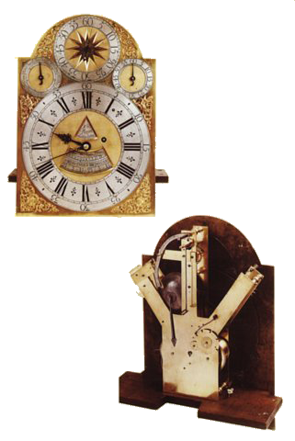William Moore, London (1701 - ?): Equation Clock with a 30-day Movement
William Moore, London (1701 - ?): Equation Clock with a 30-day Movement
A fine walnut longcase clock with equation and year calendar work. The 13 inch break arch dial has a large seconds dial in the arch and subsidiary dials below: a pendulum rise and fall subsidiary dial to the right and a day of the week dial to the left. The large chapter ring engraved with several bands: an inner ring with minute marks, roman numeral hours with fleur-de-lis half-hour marks, then a ring with minute marks and an outermost ring with 5 minute arabic numerals. Set within the punched ground, above the centre, is a triangular opening with bevelled edge enclosing a silvered panel engraved with the name: Wm Moore, London. Below the centre arbor is a large crescent-shaped cut-out with bevelled edge which displays an equation table on a large ring which rotates once a year.
This equation of time enumerates the difference between solar time, as given by a sun dial, and mean-time, which is the average of varying lengths of the solar days throughout the year. Mean noon and solar noon, at any given place, only agree 4 times during the year, at any other time of the year, the sun is before or after the mean time, and the numerical difference is shown to be either slow or fast. This ring is engraved and segmented as follows:
First line: Sun Slower - Sun Faster.
Second line: The equation of time shown in minutes.
Third line: The months of the year with their number of days in Roman numerals.
Fourth line: The day date of the month. Note, here, the slight chisel mark in the bevelled edge to the right of the date indicator showing the date 11 days hence. This accommodates the difference between the Julian and the Gregorian calendars. England changed to the Gregorian calendar in 1752. This dial is set by the small winding square next to 1 on the chapter ring.
The month duration movement with Y shaped plates joined by nine ringed pillars, with a raised central section for the anchor escapement to show seconds in the arch. It has an outside count wheel.
The case is well-proportioned and veneered throughout with selected burr walnut veneers. The trunk and hood doors are enriched with brass mouldings; the hood, flanked by reeded columns and surmounted with a bold caddy and three gilt brass finials.
Circa 1715 - 1720
Height - 9 feet
Reference: Baillie, Clutton & Ilbert. Britten’s Old Clocks and Watches and Their Makers. New York: Bonanza Books, 1956. 7th Edition. Page 440 lists this very clock.








